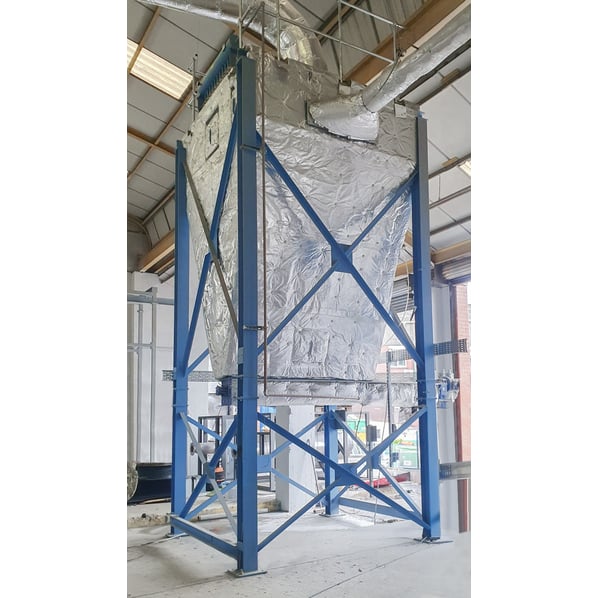Heaton Green Rotary Valve, Reverse Pulse, Venting Extractor with Heat Insulation

- Stock No
- ED2170
- Manufacturer
- Heaton Green
- Model
- HG Reverse Pulse Extractor
- Year of Manufacture
- 2018
- Serial
- 40584A
- Condition
- From a working environment, Good Condition, Current Model
- Approx Duty CFM / M³/Hr
- 2400 // 4000
- Filter Area ft² / m²
- 520ft2 // 48m2
- Other Info
- Rotary Valve Venting Unit i.e. No Fan
- Location
- Our Central Warehouse, Aldridge, UK
- Weight (kgs)
- 2800 approx.
- External Dimensions (WxDxH mm) [?]
- 2595 x 2730 x 5912mm
- Delivery Your delivery options
Description
Heaton Green Venting unit applies dust bag collector technology to continuous-duty, bin venting applications. It is typically used to vent displaced air and harmful products in bins or silos. The dust vent outlet is compact in design, using a screw conveyor and discharge valve. Bag cleaning is done with a pulse jet cleaning system allowing for continuous operation.
Features
- 48m² filter area .
- Insulated design for hot dusts or particles.
- Pulse jet cleaning.
Technical Parameters
- Maximum working temperature 100ºC.
- There is heat insulation fitted to all the exposed parts, similar to that on a boiler.
- Estimated maximum negative pressure 4000 Pa .
- Estimated maximum positive pressure 1500 Pa.
- Filter areas of 48m².
- Wide range of filter materials to suit most applications available.
- Two possible inlet connection.
Build Design
- The filter body is fitted with 24 pocket filter bags, each bag having a 2m² surface area.
- The bags are hung over a filter cassette to ensure optimum airflow and thorough cleaning of the fabric
- The filters are positioned under the pulse jet cleaning mechanism.
- Frame colour is RAL5012 light blue.
Dust Collection
There is a worm screw conveyor which takes the dust from base of unit to a rotary discharge valve outside the base unit footprint. Collection bags or buckets can be positioned under the discharge valve to collect the waste material.
There is no need to stop the unit to remove the waste.
Notes
- Venting unit so no fan.
- New bags fitted this year (2024)
How do Dust Extractors Work?
Dust collection systems work in a variety of different ways but all have general principles in common. They draw process dust and particulates from the air through a filter that first captures and separates the matter, and then discharges decontaminated air back into the workplace or environment.
Dust extractors are used in many different and varied industries and so different demands are made of them; however all have common components such as a blower (or fan), dust filter, filter cleaning system, dust container and dust removal system.
Five common types of dust collection equipment are fabric filter baghouses, inertial separators (like mechanical cyclones), cartridge collectors, wet scrubbers, and electrostatic precipitators.
Importance of Dust Extractors
Dust in the workplace can affect product quality and employee´s health. Having a dust-free environment is essential to the health and safety of the workforce. Not only does it affect the health of employees but the dust covers the equipment affecting production processes and quality of the products.
Capturing the dust at the source prevents it from spreading, done by using a dust extractor system to facilitate the important housekeeping to avoid it from accumulating.
What are Reverse Pulse Jet Dust Collectors?
Reverse Pulse Jet Dust Collectors use a jet of air to clean dust from the collector's filters. Commonly used in pleated filter cartridge units, the filters are cleaned by a series of rapid, high-pressure air jets which sends a blast or shock of air through the reverse side of the filters. In effect this shakes the collected dust from the filters into the dust collection system. The rapid reverse pulse of air allows for continuous operation with the fan running and has high collection efficiencies.
Reverse Pulse Jet Dust Collectors are the most common type of industrial dust collectors and can handle a wide range of temperatures and pressures. They are commonly used in manufacturing environments where large volumes of solids are processed, such as mineral production, food processing and metal fabrication industries.
A control unit sets the variables such as time duration between pulses, length of pulse and pressure.
Additional files
Photographs taken prior refurbishment. Our refurbishment service is not available on all machines.
Machines & equipment for sale
- Surface Treatment
- Cleaning & Degreasing
- Polishing & Belt Linishing
- Mass Finishing
- Ovens & Furnaces
- Process Cooling
- Shot Blasting
- Dust & Fume Extraction
- Air Compressors
- Rectifiers & Transformers
- Miscellaneous
- Latest Stock
- Special Offers
- Direct From Site Clearances
- Auctions
- Brand New Machines
- Available Immediately
- Sell Your Machine
Machine Alert
Get the latest machines emailed directly to you as they become available to buy online. Sign Up Now







